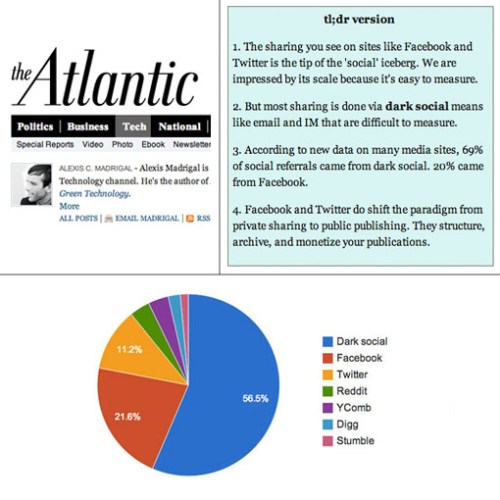Dark social: should publishers be afraid of the dark?
13 Nov, 13 | by BMJ
Have a look at any website’s analytics and ‘direct traffic’ will appear as a source alongside referrers such as Google, Facebook and Twitter. It is widely assumed that this ‘direct traffic’ is made up of users bookmarking the site or typing a site’s URL directly into a browser. However, will many readers really type out a long article URL? Isn’t it more likely that the link has been shared in a private network, such as instant messengers or email, rather than typed?
As email clients and instant messaging platforms such as Skype are not recognised as referrers, links clicked on within these networks have had referral data stripped and therefore show as ‘direct traffic’. Known as ‘dark social‘, this is the more mysterious type of traffic, where links are shared in a private yet social way.

So why should we care about dark social? As editors and publishers, we need a clear understanding of where our audiences are coming from. There’s a false sense of security in believing a greater portion of our audience is coming in through typed/bookmarked than is really the case. Our audience, it turns out, may not be loyal repeat visitors after all.
In addition, marketers spend much of their time determining how to increase website traffic and improve lead generation. They plan how to engage users on social platforms and treat each one differently, tailoring the way they communicate and what content they publish. However, if like the majority of websites up to half of visits are coming from ‘dark social’ then this needs to be factored into the equation as well.
What can we do about dark social?
While it is difficult to understand this traffic and how to cater for it, it is still important to recognise its existence and note that the ‘direct traffic’ and ‘social traffic’ statistics we pull from our analytics services are not necessarily accurate. As Alexis Madrigal, The Atlantic’s technology writer who first coined the term ‘dark social’, pointed out in his blog post, there is no easy answer.
One way to at least reduce some of the dark social numbers is to start using tracking URLs in all campaigns, so that you can tell if someone gets to a specific landing page as a result of an email that’s been sent out, rather than their click ending up in the direct traffic section of analytics.
However, this is an imperfect solution. For example, if a visitor came through on a URL tagged ‘utm_source=twitter’, then copied and pasted the URL from the toolbar into Facebook and preserved those campaign parameters, all of those Facebook visitors would be erroneously classified as visits from Twitter; likewise for conversions.
Dark search
Our new understanding of dark social comes just as analytics gurus are coming to realise that there’s something strange going on with search referrals. BuzzFeed, in a post titled Where Did All the Search Traffic Go, notes that traffic from search engines to digital publishers has dropped 30 percent from September 2012 to April 2013.
Andrew Montalenti, co-founder and chief technology officer at Parse.ly, an analytics platform, thinks there are other ‘dark’ sources of traffic. All publishers receive dark traffic, which shows as direct as there is no referrer data preserved, but now data experts are proposing that it is not all social, but that “dark search” is a factor, plus traffic referred by secure sites.
The future of dark social
Ultimately, there may be no answer to this. When attempting to track campaigns, there will always be unknowns, and in many cases they won’t even be known unknowns. The key to ‘dark social’ is to understand and appreciate that the phenomenon exists, but to also understand, as BuzzFeed so aptly explained, that “all dark social traffic is direct traffic” but “not all direct traffic is dark social”.
Measuring user engagement is difficult but irrespective of the existence of ‘dark social’ and ‘dark search’, the key to success remains the creation of quality content that individuals want to share with others.